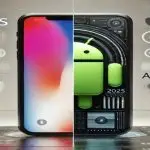The tech world is buzzing with innovations in smart glasses and wearable technology, two rapidly growing sectors that are transforming the way we interact with the digital and physical worlds. From augmented reality (AR) experiences to health monitoring, these advancements are shaping a more connected and efficient future. This article delves into the trends, benefits, and future prospects of these technologies, ensuring you stay ahead of the curve.
What Are Smart Glasses?
Smart glasses are wearable devices that integrate advanced features like AR, voice assistance, and real-time data projection. Unlike traditional glasses, these devices provide an immersive experience by blending the digital world with reality.
Key Features of Smart Glasses
- Augmented Reality (AR): Enables users to interact with virtual objects superimposed on the real world.
- Voice Control and Assistance: Hands-free operation using voice commands.
- Camera and Video Recording: High-resolution cameras for photos and videos.
- Connectivity: Bluetooth, Wi-Fi, and sometimes cellular connectivity.
- Lightweight and Fashionable Designs: Combining style with functionality.
How Smart Glasses Work
Smart glasses use miniaturized sensors, processors, and displays to provide an interactive user experience. Micro-projectors display digital information on the lenses, while sensors detect head movements and gestures to enable seamless interaction.
Examples of Smart Glasses
1. Ray-Ban Meta Smart Glasses
Developed in collaboration with Meta, these glasses offer:
- Hands-free photo and video capture.
- Built-in speakers for audio playback.
- Sleek, fashionable design.
2. Google Glass Enterprise Edition
Designed for industrial and business use, this device provides:
- Real-time notifications and instructions.
- AR-enhanced workflows for productivity.
- Hands-free communication for field workers.
3. Nreal Air
Specializing in AR experiences, Nreal Air features:
- High-quality AR gaming and streaming.
- Compact and lightweight frames.
- Compatibility with smartphones and PCs.
4. Snap Spectacles
Targeted at social media enthusiasts, Snap Spectacles allow:
- Easy photo and video sharing.
- AR features for filters and effects.
- A playful and casual design.
Benefits of Smart Glasses
1. Productivity Boost
- Real-time access to information, such as notifications and navigation.
- Enhanced workflows in industries like logistics and healthcare.
2. Enhanced User Experience
- AR applications for immersive gaming, shopping, and virtual meetings.
- Hands-free interaction for convenience.
3. Safety and Accessibility
- Improved safety features for drivers with AR navigation.
- Accessibility tools for visually impaired users.
4. Entertainment and Creativity
- Content creators can capture first-person perspectives effortlessly.
- Gamers enjoy AR-enhanced gameplay for a more engaging experience.
Wearable Technology: A Broader Perspective
Wearable technology encompasses devices like fitness trackers, smartwatches, and medical wearables. These gadgets are designed to provide real-time insights and enhance daily life.
Popular Wearable Devices
- Apple Watch Series 9: Advanced health monitoring and seamless iPhone integration.
- Fitbit Charge 6: A leading fitness tracker with in-depth health metrics.
- Oura Ring: A discreet ring that monitors sleep, activity, and recovery.
- Whoop Strap 4.0: Focused on performance optimization for athletes.
Applications of Wearable Technology
1. Health and Fitness
- Continuous monitoring of heart rate, oxygen levels, and sleep patterns.
- Early detection of potential health issues.
- Integration with health apps for personalized fitness plans.
2. Workplace Efficiency
- Wearables like the Google Glass Enterprise Edition improve productivity in industries such as manufacturing and healthcare.
- Smart badges track employee movements and ensure safety compliance.
- AR wearables enhance remote collaboration and training.
3. Entertainment and Gaming
- VR headsets like the Oculus Quest 3 provide immersive experiences.
- Smart glasses enable AR-enhanced gaming on the go.
- Fitness wearables gamify workouts with real-time performance metrics.
4. Medical Applications
- Wearables like ECG monitors and glucose trackers improve chronic disease management.
- Smart patches for drug delivery and health monitoring are in development.
- Remote patient monitoring reduces hospital visits and enables early intervention.
5. Fashion and Lifestyle
- Wearable devices are becoming fashion statements, blending aesthetics with functionality.
- Smart jewelry and clothing integrate sensors for subtle health tracking.
Challenges Facing Smart Glasses and Wearables
1. Privacy Concerns
- The integration of cameras and microphones raises concerns about data privacy.
- Companies need to ensure secure and transparent data usage policies.
2. High Costs
- Premium devices like AR glasses can be expensive, limiting accessibility.
- Affordable alternatives often lack advanced features.
3. Limited Battery Life
- Wearable devices often have limited battery life due to their compact size.
- Ongoing research aims to develop energy-efficient components and charging methods.
4. Design and Comfort
- Ensuring comfort and usability while packing advanced features is challenging.
- Innovations in lightweight materials and ergonomic designs are addressing this issue.
Future of Smart Glasses and Wearable Technology
The future looks promising for these technologies, with advancements expected in several areas:
1. Integration with AI and IoT
- AI-driven smart glasses could provide real-time language translation, facial recognition, and predictive analytics.
- IoT connectivity will enable seamless interaction with other smart devices.
2. Enhanced AR Experiences
- Improved AR capabilities for education, retail, and healthcare.
- AR-powered navigation for pedestrians and drivers.
- Mixed-reality glasses blending AR and VR for versatile applications.
3. Affordable Options
- As technology advances, prices are likely to decrease, making these devices more accessible.
- Open-source platforms may encourage innovation and reduce costs.
4. Sustainability
- Companies are focusing on eco-friendly materials and energy-efficient designs to reduce their environmental footprint.
- Recycling programs for old devices could become standard.
5. Personalized Experiences
- Wearables will adapt to individual preferences using AI-driven insights.
- Health wearables may provide predictive health analytics tailored to users’ genetic profiles.
6. Gaming and Entertainment Evolution
- The gaming industry will push boundaries with fully immersive AR and VR wearables.
- Content creation tools in wearables will open new avenues for storytelling and media.
Smart glasses and wearable technology are reshaping our interaction with the digital world. From productivity enhancements to health monitoring, these innovations are paving the way for a smarter, more connected future. As challenges like privacy and cost are addressed, these devices will become integral to everyday life. Stay tuned for more updates as this exciting tech landscape continues to evolve.
With advancements in AI, IoT, and AR, the horizon of possibilities is expanding. Smart glasses and wearables will soon become indispensable tools in our personal and professional lives, driving efficiency, creativity, and well-being. For anyone looking to embrace the future, the time to explore these technologies is now.










